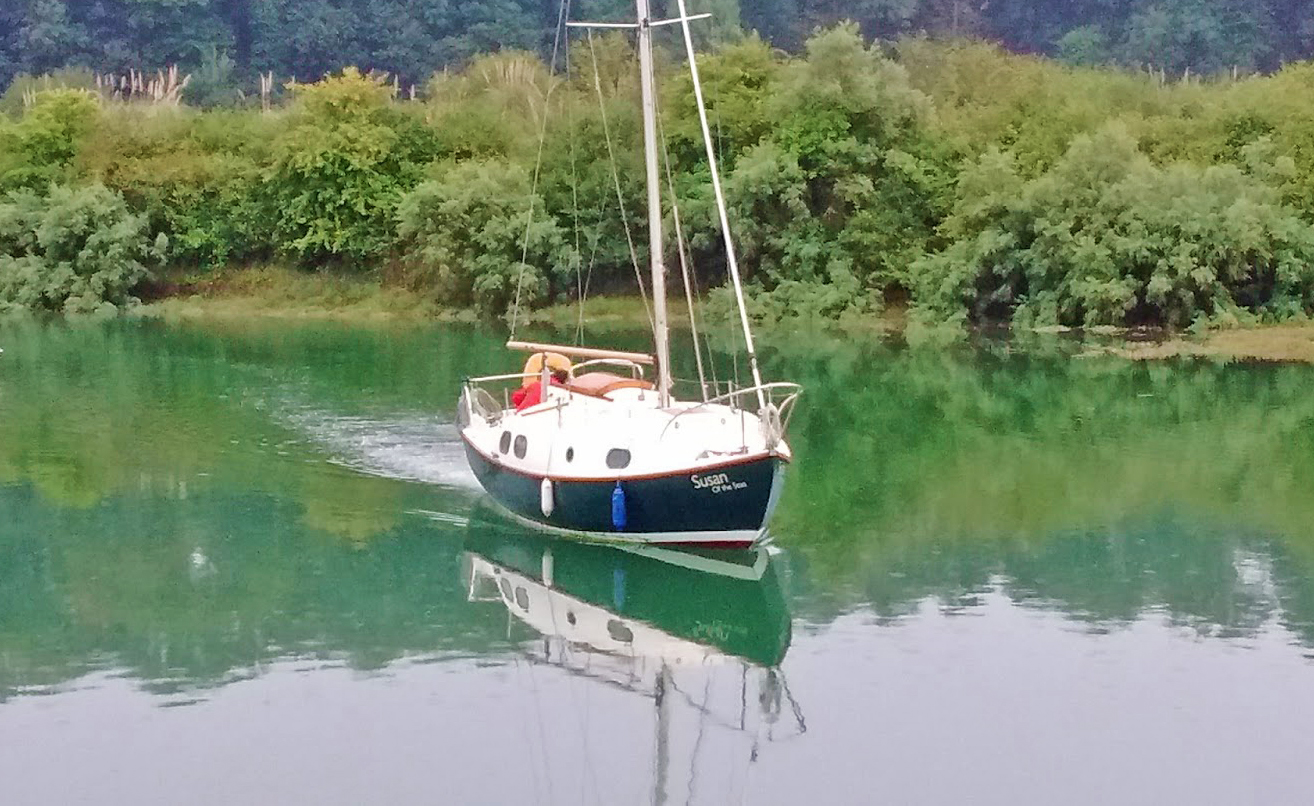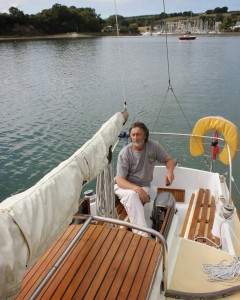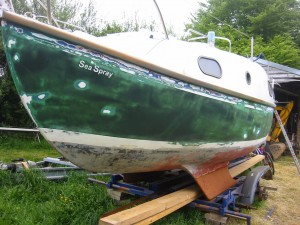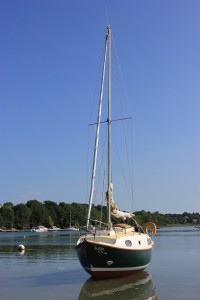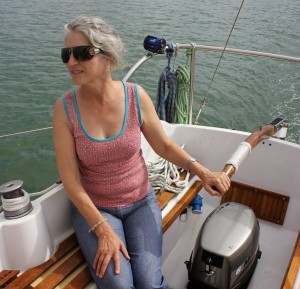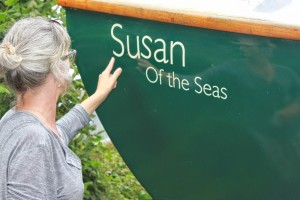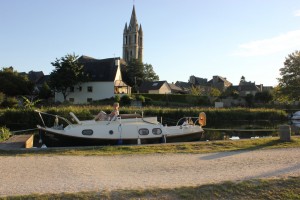David Greenwood of finding a boat that matched his desire to cruise the coast and canals, and the depth of his pockets…
I was looking for a boat for my retirement in France. I had bought a small cottage on the banks for the Rance estuary, a beautiful stretch of wide water flanked by outstanding countryside, picturesque villages and tidal mills. North, along the estuary from my home port of Plouer sur Rance, you have 20 miles of sheltered sailing to the walled coastal town of St Malo. From there westwards you have access to countless ports and harbours all along the north coast of Brittany. Head north and the Channel Islands are a day’s sail away. East takes you to the Normandy Ports of Granville, Carteret and Cherbourg. Alternatively, turn south from my home port and upper reaches of the estuary take you to the beautiful medieval town of Dinan. Lower the mast here and the Ille et Vilaine Canal will take you right through the heart of Brittany to the Atlantic. I needed a boat that could make all these trips, a good sea boat but with shallow draft for exploring creeks and backwaters, with a mast easy enough to lower for navigating the canal. I needed a boat small enough for single handing yet large enough to accommodate two people comfortably. I also wanted her to be attractive, something with ‘character.’ In truth I wanted everything.
I looked around at craft currently in production but discounted them all. Either, they didn’t meet all my requirements or they were simply too expensive, even second hand. I had just about given up the search when one evening in St Aubins Harbour in Jersey, Susan spotted a strange looking vessel sitting on the mud in a pretty derelict state. Closer inspection revealed she was an old Westerly 22, bilge keeled, Gunter rigged with a cabin stretched right across the hull and a distinctive turned-up nose. She must have been a fine vessel at one time. Her designer was DA Rayner. Clearly more research was required.
Denys Rayner was born in Muswell Hill London in February 1908. His father was a keen 6-10 metre racing yachtsman but Denys was more interested in cruising and navigation than racing. He joined the Royal Cruising Club in 1935 and, by the outbreak of the Second World War, he was a member of the Royal Navy Volunteer Reserve.
His call to action came almost immediately. He fought through the Battle of the Atlantic and also saw service in the South Atlantic and in the Far East. He was torpedoed and shipwrecked in 1944 but survived and came out of the war with a DSC and bar.
After the war, he designed and built a 20ft hard chine bilge keel Gunter-rigged plywood cruiser for a customer who required a strong shallow draft sea boat for use on the waters of the Bristol Channel. He called her the Westcoaster. Soon afterwards Rayner founded the Beacon Boats Company Ltd where about 60 other Westcoasters were produced from 1960 onwards. As well as producing plywood Westcoasters, his company was also experimenting in dinghy production, using a new material – GRP.
In 1963, Beacon Boatsmoved to larger premises in Waterlooville near Portsmouth and the company became known as Westerly Marine Construction. Rayner became its chief designer. From here he designed and built the Westerly 22, maintaining and improving on many of the design principles he had established when building the Westcoaster. He insisted that cabins should be large enough to provide ‘sitting headroom for tall men’, all running rigging should be led aft to the cockpit for ease when single handing, his boat interiors should be comfortable and convenient and, above all, he insisted that his boats should be safe and solid.
The Westerly 22 was his company’s first GRP cruiser. GRP hadn’t been around long enough for Lloyds to be able to assess the durability of the material so Rayner built his vessels under Lloyd’s supervision. Lloyds inspected hull strength and factory conditions and supervised the production process but, as an extra measure, Rayner applied additional standards of his own to the design and building process. In essence, Rayner’s boats were over-engineered. In 1966 a Westerly 22, Young Tiger,crossed the Atlantic and sealed their reputation for strength and seaworthiness. Little wonder then that current owners of early westerly yachts remain confident of their strength and reliability.
Other designs followed:- the Westerly 25, in 1964, the Westerly 30, in 1966, the Westerly Windrush (a re-worked W25), in the same year, and the Nomad (a re-worked W22), in 1967. Sadly Denys Rayner died in January 1967. Equally sadly, Westerly’s best known vessel today is the Westerly Centaur – 50 in 2019, designed in fact by Laurent Giles. Those earlier and smaller vessels designed by Rayner are often overlooked.
I didn’t find a Westerly 22 in France, but remarkably I did find a Nomad, not more than an hour’s drive away, laying, almost derelict on a farm in Normandy. She was in a sorry state, paint was peeling, the main hatch plywood had rotted, the electrics were shot and some dubious modifications to the rudder and cockpit had been ma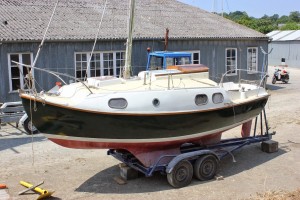 de at some point during her history. Closer inspection however, revealed that the major problem was grime and neglect. And so began a three year project to bring her back to life.
de at some point during her history. Closer inspection however, revealed that the major problem was grime and neglect. And so began a three year project to bring her back to life.
 Yellowed gel-coat was sanded back to white, sealed and polished. The hatches were rebuilt using hard wood strips over two layers of 12mm ply. The cabin, decks and hull got fresh coats of paint, all wooden fittings were treated to at least five coats of Woodcoat, and the 12 volt electrical system was replaced. In the cockpit, a previous owner had removed the inboard engine and. tried to fit a well for an outboard. A good idea, poorly executed. It had to be rebuilt. The redundant space under to cockpit floor was used to house a freshwater tank and pump. It doesn’t take much skill to renovate one of these old boats but it takes commitment and lot of sandpaper.
Yellowed gel-coat was sanded back to white, sealed and polished. The hatches were rebuilt using hard wood strips over two layers of 12mm ply. The cabin, decks and hull got fresh coats of paint, all wooden fittings were treated to at least five coats of Woodcoat, and the 12 volt electrical system was replaced. In the cockpit, a previous owner had removed the inboard engine and. tried to fit a well for an outboard. A good idea, poorly executed. It had to be rebuilt. The redundant space under to cockpit floor was used to house a freshwater tank and pump. It doesn’t take much skill to renovate one of these old boats but it takes commitment and lot of sandpaper.
So, Susan of the Seas as I re-named her, was launched last year. When we looked at her colour scheme, green hull, white topsides and buttermilk decks, she reminded us of the old green, cream and white Penguin paperback books, so we used the same typeface for her nameplates.
So how does she sail? Well, she wouldn’t earn any prizes for speed but she’s heavy, safe and predictable. In a stiff breeze she’ll heel to fifteen degrees and no more and, with the sails set well, she’ll tramp along hour after hour with just a light touch on the helm now and again. The cabin is as large as you would expect to find on a twenty six footer, and when the cabin charcoal burning stove is lit she is warm, dry and comfortable in the worst of weather. In short, she is everything I wanted, good for sea, estuary and canal, and she has a kind of ‘retro’ charm. She’ll never look new, I prefer to think of her as an elegant lady of a certain age. Best of all though, the Nomad was Rayner’s last design. She is the sum total of all his expertise and experience as a designer and, for me, that makes her a ‘classic’.


